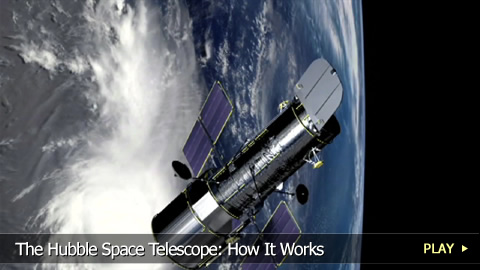How The Hubble Space Telescope Works

advertisement
VOICE OVER: Rebecca Brayton
A common misconception about telescopes is that their main purpose is to magnify objects. This is false: in fact what a telescope does is capture more light than is possible by the naked eye. The Hubble Space Telescope is one of the world's most important telescopes. Situated in orbit around Earth, but outside of its atmosphere, the Hubble gets a clearer view of the Universe and what lies within than any ground-based instrument. In this video, http://www.WatchMojo.com learns how the Hubble works.
How the Hubble Telescope Works
The Hubble Telescope is the only telescope that was designed to be serviced in space by astronauts. It is named after Edwin Hubble, the astronomer who originally discovered the universe is expanding.
The Hubble makes an orbit around the Earth every 96-97 minutes, traveling at about 8 kilometers per second, or 5 miles per second. At this speed, you could travel across the United States in about ten minutes. The Hubble about the size of a large tractor-trailer truck, measuring about 43 feet or 13 meters long.
The telescope orbits 366 miles or 589 kilometers above the earth, outside of its atmosphere. The Earth’s atmosphere distorts and blocks the light that reaches the planet. The Hubble’s position makes it possible for the telescope to provide views of the universe that greatly outdo anything possible from ground-based telescopes. A space telescope is also able to observe ultraviolet and infrared light, which are strongly absorbed by the atmosphere.
The Hubble is a Cassegrain reflector. This type of telescope features a set of two mirrors, one convex and one concave. Light enters the telescope and travels to the primary, concave mirror. The light bounces from the primary surface to the secondary, convex mirror. From here, the secondary mirror focuses the light through a hole in the center of the primary mirror which leads to the Hubble’s science instruments. Each instrument studies the light in a different way.
A telescope’s primary objective is not, as many people believe, to magnify objects. It is to capture more light than is possible by the naked eye. It is the size of a telescope’s mirror that affects how much light it can collect – the bigger the better. By ground-based telescope standards, the Hubble is not particularly big. Its primary mirror measures 94.5 inches or 2.4 meters in diameter; when some ground-based models are as big as 400 inches or 10 meters. However, its location outside the atmosphere is what gives the Hubble’s images such clarity.


